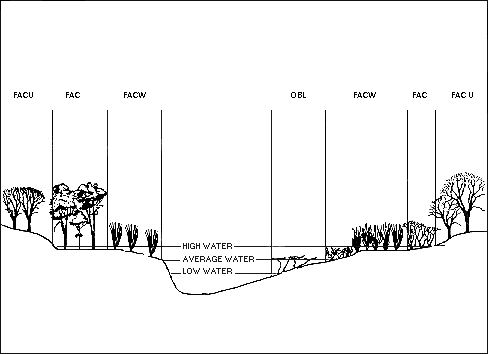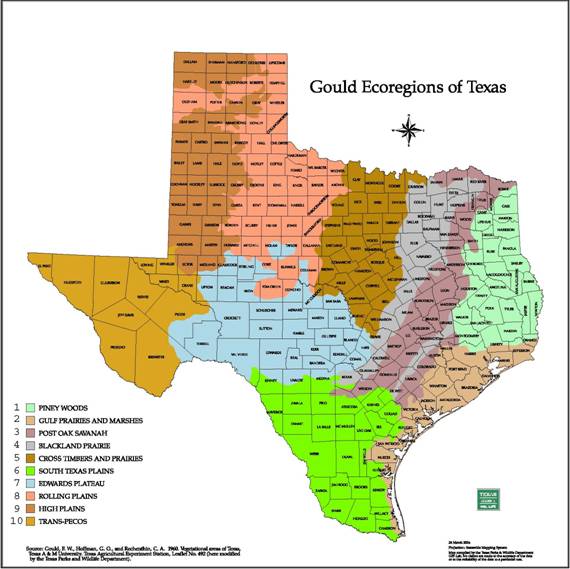The purpose of this page is to provide some information that may improve the success and quality of your mitigation areas.
Water Regime
Probably the most important thing to remember is that if you get the water regime right on the site, a wetland will develop. Even if you try to plant upland plants in it, the species that are more suited to compete in saturated soils will eventually invade the area and win out over the plant species that you planted. Obviously this would take a lot longer, and all of the money that you spent to put those ill-suited plants in there went for nothing. What you should try to do is match the flood tolerance of desirable species with the water budget of the various areas within the wetland site. Plant the most water tolerant species in the areas that stay wet the longest, and the dryer species up slope in the areas that dry out first or don’t get saturated as frequently. Generally speaking, the following diagram represents the association of the varying water regimes within a wetland complex in correlation with the wetland plant indicator categories.

Diversity
Good mitigation areas offer plant species diversities that provide benefits to wildlife throughout the year. Pecans and oaks are good mast producers, but they only provide food value in the fall. A good mix of trees would also include elm, maple or other species that seed in the spring, and fruit trees like persimmon, cherry or mulberry that produce during the summer. The same applies to the herbaceous species, the Carex spp. bloom and fruit in the spring, Cyperus spp. bloom and fruit in the fall. Considering the oak species, the White Oak group drops acorns in the fall that were fertilized that spring. The acorns from the Red Oak group take 2 years to mature and drop. If we have a rainy period during the oak bloom, the White Oak acorn crop will be poor in the fall, but the Red Oaks will drop the acorns that were fertilized the previous spring. So, planting a mixture of Red and White Oaks will increase the likelihood that there will be reliable source of acorns on the mitigation site every year. Focus on planting the more desirable large or heavy seeded species and expect to see the lighter seeded easily dispersed species to come in on their own. With a little thought about the best species to plant, you can improve the quality of your mitigation area.
Ecoregions
Just as important as the degree of soil saturation in the micro-environment are the considerations of the ecological regions within the state of Texas. This is a really big state, and the variation from North to South and from East to West is amazing. The average annual precipitation in west Texas is 8 inches, compared to 56 inches in east Texas. The upper panhandle of Texas has an average of 185 frost-free days, compared to 320 days in south Texas. Throw in the variations of soil chemistry that limit the range of some plant species, and it is easy to see how important it is to give serious consideration to the ecological regions within the state. The following map shows the 10 Vegetation Areas in Texas.

To help put some of the pieces of this puzzle together, we combined the information from several resources that will help you decide which plants to plant where. We used the information from the Checklist of the Vascular Plants of Texas to determine where certain plant species are found within the state. We used the US Fish and Wildlife Services’ National List of Plant Species That Occur in Wetlands: South Plains (Region 6) to provide an indication of the water regime in which the wetland plants in Texas are usually found. We also included information about those plant species that are valuable as wildlife food.
We are not here to defend the information in these resources. Some of you have Cypress trees growing in your front yards that are not in a wetland, and you have seen Loblolly pines growing in very wet areas. These are exceptions to the rule, and not where those species should normally occur, or where they are best suited to compete with other species. You may also know of a naturally occurring species that is growing in a certain area, but the species is not listed in that particular Vegetative Area. It may be close to the Vegetative Area line, or you could have found a remnant ecosystem that is isolated and too small to map.
Some of the species on the list would be undesirable to plant in your mitigation area. Chinese Tallow and Saltcedar are on some of the lists, but you shouldn’t plant them in a mitigation area. As a rule, select the best, most beneficial, native species that is available for your mitigation site. Feel free to use your best professional judgment to apply or override any information found on the lists.
The Data
We are providing a list of species, either trees or herbaceous, for each of the 10 Vegetative Areas from the map above. Each species is assigned to an indicator category. Species listed as Obligate Wetland (OBL) occur almost always under natural conditions in wetlands (estimated probability >99%). Facultative Wetland (FACW) plants usually occur in wetlands (estimated probability 67%-99%), but are occasionally found in non-wetlands. Facultative (FAC) plants are equally likely to occur in wetlands or non-wetlands (estimated probability 34%-66%). Facultative Upland (FACU) plants usually occur in non-wetlands (estimated probability 67%-99%), but are occasionally found in wetlands (estimated probability 1%-33%).
Just in case you are not yet totally confused: A positive (+) or negative (-) sign is used with the Facultative indicator categories to more specifically define the regional frequency of occurrence in wetlands. The positive sign indicates that the species is more frequently found in wetlands, and a negative sign indicates that the species is less frequently found in wetlands.
An NA indicates that there is No Agreement on the wetland status of this species. The National Indicators for the NA species range from UPL to OBL and include Native and Introduced species. You should do a little more research if you plan to use a NA species in your planting.